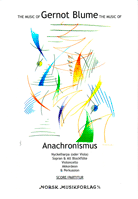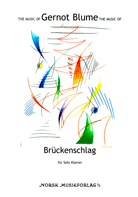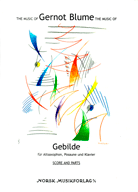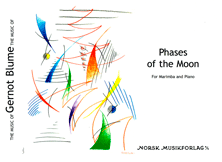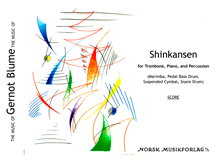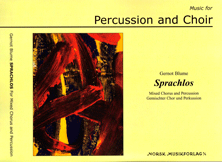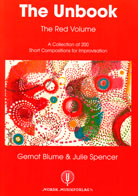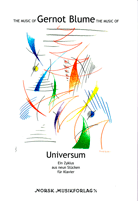Compositions
Kleines Ensemble
Anachronismus
By: Gernot Blume
Nyckelharpa (or Viola), Soprano & Alto Recorder, Cello, Accordion, Percussion
Anachronismus, written for a folk-like chamber ensemble, is characterized by cultural influences that have shaped my musical outlook since childhood: Irish and Bulgarian traditional music as well as Baroque and contemporary Western art music. The pastiche of the global village is a complicated one, in which harmony and dissonance have to be able to co-exist, or else is becomes a romanticized projection. In this piece, tonality knows of its necessary deconstruction, yet there is still a yearning for harmony in every dissonance.
Solo Piano
Brückenschlag
By: Gernot Blume
Brückenschlag – which means bridging or crossover in German – experiments with the collision of disparate cultural vernaculars – the Western piano, the music of the Ghanaian Ewe people, and the world of Javanese gamelan. Premiered with gamelan and the Ghanaian lead drum, atsimewu, at Lewis & Clark College in Portland, Oregon, 2002, at the occasion of the concert event “Soundings” featuring eight premieres of compositions of mine, Brückenschlag in the solo piano version also reverberates with these three cultures which have influenced me so profoundly for nearly twenty years.
more
Flute, Cello and Piano
Farbenspiel – Color Play
By: Gernot Blume
To the Memory of My Father Karlheinz Blume (1935 – 2000)
My father, Karlheinz Blume (1935-2000) was a very fine hobby painter. He loved to play with colors. As a young man he wanted to become a professional artist, but the times and his environment led him towards a more pragmatic career in economics. When it was my turn, he supported my path in music and became the single most important sponsor of my formative years of artistic training, perhaps vicariously fulfilling through me his own dreams of a life in the arts. For this and much more I am forever grateful to him.
Color Play investigates the confrontation of these three divergent instruments, which however remain in their respective spheres of sound. There is no tonal connection between the instruments, no blending or melting, but instead there is enduring contrast. Each instrument unfolds its own unique texture, and yet they weave one picture together. Rhythm, not tonality, provides the inner coherence. Only the respective solo parts in the center of the piece interrupt the soundscape of rhythmic interlacing after this initial structure has gradually dissolved, only to reemerge toward the end. Color play demands great rhythmic precision and strengthens ensemble interaction in a chamber music setting without a conductor. The certainty of an inner pulse carries the musicians across a sound journey through the field of tension between cubist edginess and late-impressionistic color blurring.
Vibraphone and Piano
Flying Nowhere
By: Gernot Blume
The basis of “Gebilde” (thing, structure) is rhythm. The instruments are connected by way of rhythmic hocketing or interlocking, as is typical in many musical cultures of the world. For Western musicians the challenge is to internalize a shared sense of pulse so strongly that each player knows exactly where his or her part falls with respect to the others. This produces what jazz musicians call “groove.” Playing the pitches is less than half the work. The piece begins to move – and to move us – when this sense of pulse is so strong that it ticks like a clock and draws our attention to it, even where it is not played explicitly, which means when it is played as rests – in other words, when – in the jazz language – “it grooves hard.”
Saxophone, Trombone and Piano
Gebilde
By: Gernot Blume
The basis of “Gebilde” (thing, structure) is rhythm. The instruments are connected by way of rhythmic hocketing or interlocking, as is typical in many musical cultures of the world. For Western musicians the challenge is to internalize a shared sense of pulse so strongly that each player knows exactly where his or her part falls with respect to the others. This produces what jazz musicians call “groove.” Playing the pitches is less than half the work. The piece begins to move – and to move us – when this sense of pulse is so strong that it ticks like a clock and draws our attention to it, even where it is not played explicitly, which means when it is played as rests – in other words, when – in the jazz language – “it grooves hard.”
Small Ensemble
Klangbewegungen
By: Gernot Blume
Sound Movements is an improvisatory composition in eight movements, which gives the performing musicians a considerable amount of interpretive freedom. Poems serve as a score and as performance instructions. The musicians have to listen to each other carefully and respond to each other’s musical statements according to the structural and textural ideas the composer has fixed.
The movements are entitled: Beginning, Source, Spilling, Agreement, Conversation, Reactions, Play, and Prayer.
All movements are part of a cyclical whole and should be played in the context of the entire piece. Any combination of instruments is possible. An ensemble of 4 to 7 players is most recommended.
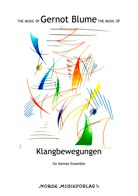
Marimba and Piano
Phases of the Moon
By: Gernot Blume
Sound Movements is an improvisatory composition in eight movements, which gives the performing musicians a considerable amount of interpretive freedom. Poems serve as a score and as performance instructions. The musicians have to listen to each other carefully and respond to each other’s musical statements according to the structural and textural ideas the composer has fixed.
The movements are entitled: Beginning, Source, Spilling, Agreement, Conversation, Reactions, Play, and Prayer.
All movements are part of a cyclical whole and should be played in the context of the entire piece. Any combination of instruments is possible. An ensemble of 4 to 7 players is most recommended.
Trombone, Piano and Percussion
Shinkansen
By: Gernot Blume
Commissioned by Hiroshi and Shiori Tanaka, Tokyo, Japan.
This piece was composed with the memories in mind of riding on the Shinkansen trains in April 2004, between Tokyo, Nagoya, and Osaka. I was struck by the contrast of the relative silence and motionlessness of my familiar environment inside the train, and the life of unknown worlds through which I passed. Only a quiet gaze connected me to the outside, and the machine that hurled me through quickly changing landscapes remained the only world I inhabited, making the fleeting images appear like a dream.
Mixed Chorus and Percussion
Sprachlos
By: Gernot Blume
“Sprachlos,” (without language, speechless), is inspired by many of the world’s musical languages that emphasize the human voice primarily as an instrument rather than a vehicle for transporting meaning. Many cultures have for centuries treated the voice in ways my own Western horizon has only recently begun to investigate. The resulting textures have often struck me as rather “modern,” or “experimental,” even though they are deeply rooted in traditional cultural value systems. The musical idioms and cultures referenced in “Sprachlos” are unified by my own, decidedly Western identity and aesthetic values. I do not attempt to imitate the world’s musical traditions, but rather to let them resonate in my own imagination, filtered, abstracted, displaced. I am aware that this kind of musical concept runs the risk of being criticized as neo-colonialist cultural appropriation.
However, musical systems and languages and musicians of any tradition have always been interested in each other. My leaning toward a multi-stylistic collage is perhaps related to Henry Cowell’s desire to “live in the whole world of music.” I do not mean to appropriate, but instead to observe and reflect. I visit humbly, respectfully, but I also leave behind and return home. I admit to the control of my authorship and to the subjectivity of my exoticisms.
“Sprachlos” reflects my experiences as a musician and as an ethnomusicologist with varied musical cultures, but it is ultimately the texture of my own dreams as I imagine and remember distant lands and sounds. And for me today, all lands are as distant as they are close, even my own. They are as much my lands as I belong to none of them. The imaginary journey of “Sprachlos” does not require prior experience with the referenced musical vernaculars, but it also does not deny its global frame of reference.
Jazz Ensembles
The Unbook
By: Gernot Blume
The Unbooks are a collection of short compositions for players of all musical backgrounds and instruments, who want to improvise. The pieces can be performed with any instrumentation. Some pieces have piano scores and separate harmonization parts, some focus on textural ideas rather than a standard tune format. Many are for improvising outside the norms of the jazz tradition, while many others are written as standard lead sheets with chord symbols. Numerous compositions may also be played as completely written out miniatures, without improvisation, or be organized in suites or medleys. Musicians, who work with different strategies and traditions of improvisation can find in these volumes compositional material to frame, structure or guide their performances.“The Unbooks“ can be used as an alternative kind of “Real Book,” with references to a broader stylistic spectrum.
Solo Piano
Universum
By: Gernot Blume
“Universum” (“Universe”) is a collection of nine episodes for solo piano, referencing different stylistic languages, which have all been important influences for me, in particular the musics of Olivier Messiaen, Alban Berg, and Igor Stravinsky. The programmatic allusion to the universe articulates my desire to hear and transform into my own language, as American composer Henry Cowell once said, “the whole world of music.”
Marimba Quartet
Why
By: Gernot Blume
“Why” was written in 1991, originally for string quartet, while I studied jazz, world music, and composition at the California Institute of the Arts. I wanted to explore the possibilities of this classical ensemble type when confronted with jazz phrasing, the rhythmic intensity and drive of jazz, and harmonic structures that exist somewhere between jazz and contemporary music. The piece is also the result of my immersion in Balinese gamelan orchestras and Ghanaian drum ensembles, with particular emphasis on the aspects of interlocking melodies, angular phrases, and steady bass lines.
Much string music has been arranged for mallet keyboard instruments – so this is no exception. But I found that through the different instrumentation the piece transformed into a completely new entity, although all pitches remain the same. That is why the marimba version is valuable to me – it is not merely a copy of the original. In some ways the marimbas add to the feeling of displacement, the “Verfremdung” of different cultural allusions, without which my music cannot exist. Music begins for me where minimally two elements collide. In the case of “Why,” this aesthetic program is also reflective of the context of the composition. I was dismayed after a fellow pianist was almost stabbed to death in a mugging. “Why” expresses fear and anguish, but also the will to overcome.
“Why,” for Marimba Quartet, was first recorded in 1996 on the Equilibrium Label, with musicians from the University of Michigan Percussion Ensemble under the direction of Michael Udow.
Approximate performance duration: 7’30”

